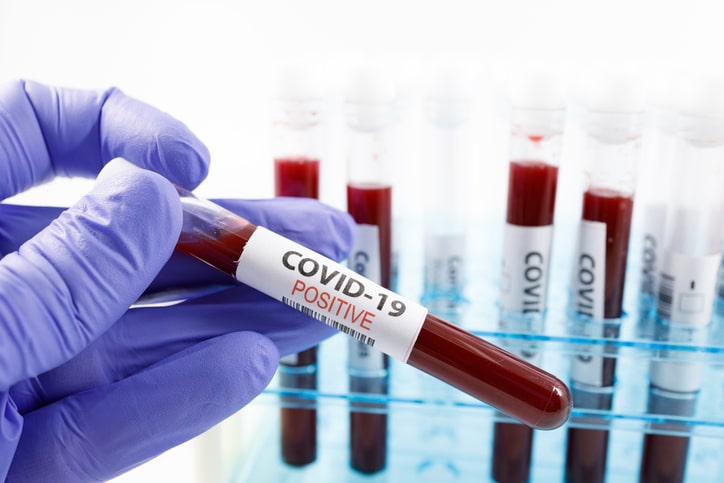Dec 02, 2020

We have seen many updates and changes to COVID-19 (SARS-CoV-2) since the pandemic started. As of January 1, 2021 there were even more changes as outlined below. Also the CMS MS-DRG grouper will be updated to version 38.1 to accommodate the changes. Be sure to review your facility’s encoder to be sure you have the correct codes as outlined below. I will not be discussing CPT codes for vaccines and therapeutic injections however I did include a link to these codes in the references. Coders should keep this list below handy as they begin coding January 1, 2021 cases.
What are the New Diagnosis Codes Effective January 1, 2021?
- Z11.52, encounter for screening for COVID-19 (We previously used Z11.59 before the pandemic. Do not use Z11.52 during pandemic. Must wait until pandemic is over to begin using this code)
- Reported for people who are asymptomatic and test negative
- Z20.822, contact with and (suspected) exposure to COVID-19 (We previously used Z20.828 for this)
- Z86.16, personal history of COVID-19 (We previously used Z86.19 for this)
In addition, the committee proposed adding a new code that would allow providers to report COVID-19-caused pneumonia:
- J12.82, pneumonia due to coronavirus disease 2019 (We previously used U07.1, J12.89 for this)
- Includes the inclusion terms, “pneumonia due to COVID-19” and “pneumonia due to severe acute respiratory syndrome coronavirus 2”
- Existing coding guidance (prior to 1/1/21) for COVID-19-related pneumonia instructs coders to report two ICD-10-CM codes for the condition: U07.1 (COVID-19) and J12.89 (other viral pneumonia).
- We wrote AHA to see if U07.1 and J12.82 would be reported, or only J12.82). AHA has replied that BOTH U07.1 AND J12.82 would be reported as of January 1, 2021 for viral pneumonia due to COVID-19. They are not following the existing OCG on using one combination code in this situation.
The creation of the new combined code would “improve coding specificity for pneumonia due to [COVID-19],” according to committee members.
Finally, the committee proposed adding a new code for multisystem inflammatory syndrome-a condition associated with COVID-19, particularly in children:
- M35.81, multisystem inflammatory syndrome (Previously M35.8)
- M35.89, Other specified systemic involvement of connective tissue (Previously M35.8)
What are the New Procedure Codes Effective January 1, 2021?
Remember, only assign the X COVID-19 codes when the drug is being used to treat COVID-19 ONLY, not some other disease.
The drug administration code should only be assigned ONCE even though it may be administered more than one time in the hospital stay. The first 12 codes below were created to be used starting August 1, 2020:
XW033E5 – Introduction of remdesivir (VEKLURY®) into peripheral vein, percutaneous approach
XW043E5 – Introduction of remdesirvir (VEKLURY®) into central vein, percutaneous approach
XW033G5 – Introduction of sarilumab (KEVZARA®) into peripheral vein, percutaneous approach
XW043G5 – Introduction of sarilumab (KEVZARA®) into central vein, percutaneous approach
XW033H5 – Introduction of tocilizumab (ACTEMRA®) into peripheral vein, percutaneous approach
XW043H5 – Introduction of tocilizumab (ACTEMRA®) into central vein, percutaneous approach
XW13325 – Transfusion of convalescent plasma (nonautologous) into peripheral vein
XW14325 – Transfusion of convalescent plasma (nonautologous) into central vein
XW013F5 – Introduction of other new technology therapeutic substance into subcutaneous tissue, percutaneous approach, new technology group 5
XW033F5 – Introduction of other new technology therapeutic substance into peripheral vein, percutaneous approach, new technology group 5
XW043F5 – Introduction of other new technology therapeutic substance into central vein, percutaneous approach, new technology group 5
XW0DXF5 – Introduction of other new technology therapeutic substance into mouth and pharynx, external approach, new technology group 5
The four codes above should only be assigned for therapeutic substances being used to treat COVID-19 that do not have their own specific code. For administration of “other therapeutic substances” that are being used to treat medical conditions other than COVID-19, see ICD-10-PCS table 3E0. For example, code 3E033GC describes “Introduction of other therapeutic substance into peripheral vein, percutaneous approach.” If a code exists elsewhere and is being used to treat COVID-19, then use that other code. Example includes stem cell transfusion. There is an existing code for stem cell transfusion so use that code.
Example for Dexamethasone (orally or intravenously) when used to treat COVID-19, assign the drug from the table 3E0 for introduction of anti-inflammatory drug. Do NOT assign an XWO drug code.
The below are valid as of 1/1/2021:
XW013U6 -Introduction of COVID-19 vaccine into subcutaneous tissue, percutaneous approach, new technology group 6
XW023U6 – Introduction of COVID-19 vaccine into muscle, percutaneous approach
XW013S6 – Introduction of COVID-19 vaccine dose 1 into subcutaneous tissue, percutaneous approach, new technology group 6
XW013T6 – Introduction of COVID-19 vaccine dose 2 into subcutaneous tissue, percutaneous approach, new technology group 6
XW023S6 – Introduction of COVID-19 vaccine dose 1 into muscle, percutaneous approach, new technology group 6
XW023T6 – Introduction of COVID-19 vaccine dose 2 into muscle, percutaneous approach, new technology group 6
XW033E6 – Introduction of etesevimab monoclonal antibody (LY-CoV016) into peripheral vein, percutaneous approach
XW043E6 – Introduction of etesevimab monoclonal antibody (LY-CoV016) into central vein, percutaneous approach
XW033F6 – Introduction of bamlanivimab monoclonal antibody (LY-CoV555) into peripheral vein, percutaneous approach
XW043F6 – Introduction of bamlanivimab monoclonal antibody (LY-CoV555) into central vein, percutaneous approach
XW033G6 – Introduction of REGN-COV2 monoclonal antibody (cocktail of casirivimab and imdevimab) into peripheralvein, percutaneous approach.
XW043G6 – Introduction of REGN-COV2 monoclonal antibody (cocktail of casirivimab and imdevimab) into centralvein, percutaneous approach
XW033H6 – Introduction of other new technology monoclonal antibody into peripheral vein, percutaneous approach
XW043H6 – Introduction of other new technology monoclonal antibody into central vein, percutaneous approach
XW013H6 – Introduction of other new technology monoclonal antibody into subcutaneous tissue, percutaneous approach, new technology group 6
XW033L6 – Introduction of CD24Fc immunomodulator (SACCOVID™) into peripheral vein, percutaneous approach
XW043L6 – Introduction of CD24Fc immunomodulator (SACCOVID™) into central vein, percutaneous approach
XW0DXM6 – Introduction of baricitinib (Olumiant®) into mouth and pharynx, external approach
XW0G7M6 – Introduction of baricitinib (Olumiant®) into upper GI, via natural or artificial opening
XW0H7M6 – Introduction of baricitinib (Olumiant®) into lower GI, via natural or artificial opening
XW013K6 – Introduction of leronlimab monoclonal antibody (PRO 140) into subcutaneous tissue, percutaneous approach, new technology group 6
https://www.cms.gov/medicare/icd-10/2021-icd-10-pcs
Coders can find the official documents below at the link in the references.
The updated ICD-10-CM Official Coding and Reporting Guidelines are expected to be available here by 1/1/21 https://www.cdc.gov/nchs/icd/icd10cm.htm
What Will be the Challenges?
A big change will be the use of a new specific code for COVID-19 testing that turns out to be negative but patient is asymptomatic, Z20.822, contact with and (suspected) exposure to COVID-19. Coders are used to using the generic code of Z20.828. We are very glad that a new specific code has been developed for this situation. Remember that coders CANNOT use the screening code (Z11.52) until there is no longer a pandemic. During AHA’s COVID-19 coding presentation on December 1, 2020, Nelly stated that an official announcement will be given as to when the COVID-19 pandemic is official over. This change will once again affect data capture and reporting since the coding guidelines for negative testing of COVID-19 has changed 3 times since the pandemic began.
Personal history of COVID-19, Z86.16 is a welcome addition to specifically identify a history of this virus. This will greatly help statistical analysis. This code is only used when the patient no longer has COVID-19 and no longer is being treated for any residuals of COVID-19. This could get confusing in some cases if the documentation is not very clear. Coders are cautioned not to assume and to query the provider for an answer.
Remember, COVID-19 has to be confirmed in order to code U07.1, COVID-19. The test results can be coded as a confirmed COVID-19 case, U07.1. However if the test results are inconclusive and the MD documents “probable,” “suspected” or “inconclusive” COVID-19, do NOT assign code U07.1. Instead, code the signs and symptoms. This was validated during AHA’s presentation on 12/1/20. If there is ever any question, it is “best practice” to query the provider.
Be sure to keep a list of all COVID-19 procedures so that they can be identified in the medical record and reported with appropriate ICD-19-PCS codes.
References
https://www.cms.gov/files/zip/icd-10-ms-drgs-v381-effective-january-1-2021.zip
https://www.cms.gov/medicare/covid-19/medicare-billing-covid-19-vaccine-shot-administration
https://www.cms.gov/medicare/medicare-part-b-drug-average-sales-price/covid-19-vaccines-and-monoclonal-antibodies
https://www.cdc.gov/nchs/icd/icd10cm.htm
https://www.cms.gov/Medicare/Medicare-Fee-for-Service-Payment/AcuteInpatientPPS/MS-DRG-Classifications-and-Software
HIA’s comprehensive auditing approach includes acute coding audits and Clinical Documentation Integrity (CDI) audits.
Subscribe to our Newsletter
Recent Blogs
Related blogs from COVID-19 Coding , Medical Coding Tips
Subscribe
to our Newsletter
Weekly medical coding tips and coding education delivered directly to your inbox.





